This third installment of D. C. Meijer Jr.’s article on Amsterdam civic guard portraits focuses on works by Bartholomeus van der Helst (Oud Holland 4 [1886]: 225–40). Meijer’s article was originally published in five installments in the first few issues of the journal Oud Holland. For translations (also by Tom van der Molen) of the first two installments, see JHNA 5, no. 1 (Winter 2013).
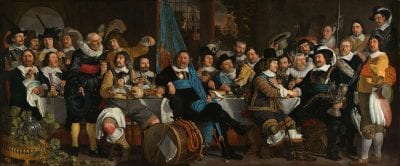
Would the old painters have risen from their graves at the opening of the new [Rijks]museum, 1 On the one hand, he would have been disappointed that his world-famous meal of civic guards no longer attracted attention and admiration to the degree it did in the Trippenhuis (fig. 1).2 On the other hand, he would have rejoiced over the publication of the real name of his good wife, Anna du Pire,3 and over the rejection of any flirtation with such a distinguished lady as Constantia Reijnst. The catalogues of the Amsterdam Historical Exhibition (1878)4 and the Rijksmuseum (1880)5 mention [both] his wife and the foolish misunderstanding generated by Jan Vos’s poem on the portrait that Van der Helst painted of this lady.6 In the same essay in which Dr. P. Scheltema7 announced this misunderstanding, he corrected another mistake that had originated from the name “Van der Helsten-doelen,” sometimes used for the Longbow Civic Guard Hall. That name derived from another Van der Helst, the brother of the painter, or so it is believed.8

Even more than the rediscovery of his wife’s name, the great Amsterdam portrait painter might have rejoiced in the reappearance of the masterpiece he painted in 16399 for the civic guards of district eight (fig. 2). This work, after having starred first in the Harquebusiers guild hall and later in the “grote krijgsraadkamer” in the city hall on the Dam, has been hidden for years in a cramped office in the present city hall (the room of the city secretary). That room was only rarely opened except for art lovers intent on seeing the city’s paintings, and it was practically impossible even to view the picture when the room was functioning as an office.
Truly the change from this cramped room to the Rembrandt hall of the new [Rijks]museum is enormous, but not undeserved! Van der Helst poured into his painting the power of robust forms and lush attire of the armed civilians, glowing with life. His figures are carefully treated and yet rendered with a breadth of stroke. They reveal a striking truth and a beautiful range of color. Remarkably, when this genius artist painted the delightful scene, he was only twenty-eight years old!10
It is a cheerful, stimulating image from the most resplendent times of our peoples’ history. The group of men depicted, full of vitality, courage, and force, freely look around, proud of their self-acquired wealth. Rich brewers and ship owners are depicted, the industrious shipbuilders and anchor smiths of the “Lastaadje,” the part of the city along the Oude Waal and Boomsloot, between the Geldersche Kade and de Oude Schans, that was so prosperous in those days. It was a good idea for the young painter to settle on the Nieuwmarkt,11because it is here that he found neighbors who entrusted him with the important task of immortalizing their appearances.
Van der Helst has, it seems, chosen the moment when a new ensign is welcomed. In the middle stands Captain Roelof Bicker in a somewhat melancholic posture, with riding boots and the commander’s cane in his hand. He was the cousin of the burgomasters with the same last name, who made themselves famous in 1650,12 and the son of councilman Jacob Bicker, who was commissioner of small affairs, a position he would change for that of alderman a few years later. For his first name he thanked his mother’s father, Burgomaster Roelof Egbertsz de Vrij. And we thank him for the protection he offered to Amsterdam art by commissioning this civic guard piece, and also a couple of years later for commissioning a companion piece of himself next to the portrait of his wife Agatha, daughter of Burgomaster Dirk de Vlaming van Outshoorn, which was painted by Michiel Mierevelt. In the pendant portrait of Roelof Bicker, Van der Helst acquitted himself of that task in such a way that nowadays it still reaps the admiration of any art lover.13
Next to Roelof is his lieutenant, dressed in black, with a heavy collar and a partisan in his hand. The lieutenant’s aristocratic profile distinguishes him as a man of noble birth. This is Jan Michielsz Blauw,14 baring his bald head to greet the new ensign, who is dressed from head to toe in white moiré satin. The latter descends the stairs of a low pavement with the white flag (on which the city coat of arms is held by lions) pressed against his shoulder. Between these two figures are a couple of civic guardsmen, drinking and seated on barrels, with a spaniel at their feet. Another guard leans from a window and toasts the captain with a Rhine wine glass on a fine glass holder (bekerschroef). Furthermore, to the right appear more civic guardsmen, including a beautiful figure wearing a broad orange sash, who is also seated on a barrel, and one of the sergeants, recognizable by his halberd, boots, and gloves. The ensign is Pieter Hulft, whose father, the rich brewer from “De Haan,” had been lieutenant in this company for a long time. The old Hulft was also governor of the East India Company, an honor which was later passed on to his youngest son Jan.
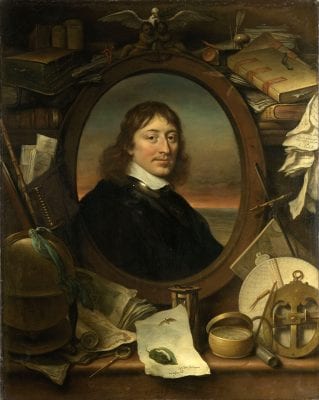
Without doubt the ensign is remembered with many a savory drink for the heroic way in which his mother’s father, Burgomaster Pieter Dircksz Hasselaer, in his youth occupied the post at the siege of Haarlem. Pieter Hulft died young, without having distinguished himself, but his brother Gerard (fig. 3) showed that the blood of the Hasselaers flowed through his veins. The large and new city hall was too small for Gerard’s courage and spirit, and sitting on pillows embroidered with the city’s arms [the pillows of the city council’s seats] became too uncomfortable, as his fatherly friend Joost van den Vondel expressed it. [Vondel’s] heart opened when he thought of this young hero, who, after “having conquered the Thames with our fleet,” grabbed the sword himself as director-general of the East India Company, to chastise the enemies of the company “on the delightful trail of the Dutch Admirals,” until a bullet felled him during the conquest of Colombo on Ceylon, in 1656, “in the bloom of his life.”15
It is probably thanks to the connections of the Hulft family with the tropics that we also see a small black fellow in the painting, laden with the cloak of one of the gentlemen. That cloak is bright red. But Van der Helst knows how to spread the most splendid colors so suitably over his painting that they never clash anywhere. Above the black boy can be seen a civic guardsman with reddish-blonde hair who fires his musket. Further to the left, [emerging] from a group of pikes, a second sergeant comes forward in a black velvet jacket with a flat collar and a blue gold-trimmed sash. I consider him to be Joachim Rendorp,16whose family was related to the Bickers by the marriage of his grandfather, who came from Lüneburg, with the sister of the sixteenth-century Burgomaster Pieter Bicker, the common ancestor of this numerous and notable family. In an even closer connection, Rendorp was allied with the Hulfts through his marriage with Brechje, the sister of the ensign, and after the extinction of this family the “De Haan” brewery came into the possession of the Rendorp family. Moreover, with the sweeping title of Freemen of Marquette (after a manor in Kennemerland, decorated with that name after a Hainaut fief), he played no small part in the history of Amsterdam during the eighteenth century.
A peculiar detail of this civic guard piece is the depiction of a six-year-old boy whose soft childish face contrasts with his martial attire. He not only carries a small pike in his hand, twice as big as himself, but also a sword on his side. Dressed in purplish gray, wearing a white sash, a plumed hat, and little gloves, he is a complete officer of the civic guards in miniature. In whatever relation the boy might have stood to one of the officers,17 we may assume he was the favorite of the company and possibly he has recited a little poem on the occasion of the arrival of the new ensign. It is not plausible to think of a pro forma occupation of civic guard rank in the manner that nowadays young princes are assigned to high ranks in the army. The same is true with other appearances of children in the civic guard pieces.18
According to Mr. Scheltema the quay in front of the brewery is the stage of the scene. This is not impossible, but there are not many other clues in the painting beyond the piles of empty barrels and the rooster [in Dutch, Haan, referring to the name of the brewery] on the bottom of one of the barrels. Of course, the civic guardsmen, insofar as they had no preference for Rhenish wine, would not have drunk anything else than Rooster-beer on this occasion.
I have deliberately dwelled on this piece because I believe that later, when the museum will undoubtedly focus its attention less on the new building than on the paintings that hang there, this piece will be discussed by foreign connoisseurs and placed in the ranks of the foremost masterpieces of the world and will certainly receive the honor of being reproduced. (Until now, only the portrait of Roelof Bicker from the group portrait has been engraved, by [Jacob] Houbraken in the last century). It [The Company of Captain Roelof Bicker and Lieutenant Jan Michielsz Blaeuw] is less cool of tone than the Civic Guards Meal [Company of Captain Cornelis Witsen and Lieutenant Johan Oetgens van Waveren Celebrating the Treaty of Münster, fig. 1]. Because of the size of the piece, with its thirty-two life-size figures measuring, at a width of 7.50, only 2.30 meters in height, naturally the demands of [compositional] concentration are of less significance, the same as in for example, a sculpted frieze depicting a procession. Thus The Company of Captain Roelof Bicker and Lieutenant Jan Michielsz Blaeuwescapes the reproach that has sometimes been leveled at the Civic Guards Meal: The equal distribution of light also divides the attention of the spectator. The action is not concentrated in one main group of civic guards.
It is in this, as well as in the desperately [wanhopig] finished character of the piece, to put it that way, that one seeks an explanation for why the otherwise excellent Civic Guards Meal19 leaves many indifferent in the long run. This sentiment will likely not improve since the light of the [new Rijksmuseum’s] Hall of Honor apparently is not as favorable as the Trippenhuis had been for the painting. The Civic Guards Meal has, in the new museum, already been hauled from one compartment to the other and now, as I write this, it has ended up in the Rembrandt room. Rembrandt is therefore now in the company of a large composition by Van der Helst on both sides. Thus, the opportunity is again present to make the important comparison between Rembrandt and Van der Helst: both great masters, both born Dutchmen who never studied art abroad, who worked at the same time, in the same city, with the same subjects, now decorating the same hall.20Yet the two men differed enormously in their conceptions of art, its means, and goals. Here is a striking and grand image of Dutch originality and Dutch individualism; the comparison shows those traits from their best side!
The Civic Guards Meal (fig. 1) is too well known and has been described too often to make it necessary to dwell on it very long. These are the burghers of the south side of the Kalverstraat and the canal running along it (Rokin, Nieuwe Zijds Voorburgwal and Nieuwe Zijds Achterburgwal21), the squad of district 17, who offer each other this banquet on the occasion of the long-expected peace and who have occasioned it to be brought onto canvas for eternal remembrance, to decorate the same room in which it was held, the old hall of the Crossbow Civic Guard. The building has nowadays disappeared; it was on the spot where today one finds the Roman Catholic church “Geloof, Hoop en Liefde,” on the Singel near the Heiligeweg.22 On the other side of the canal, which one can see through the windows in the painting, several stepped gables are crowned with Agnus Dei-statuettes. That is the brewery “het Lam,”23 with the adjoining Mennonite meeting place named after it, nowadays the common church of Amsterdam Baptists. To the left of the windows, one sees an arch in the painting that was probably not present in the hall but just a fantasy.
It is peacetime in the painting, most of the civic guards have laid down their weapons. The standard (blue with the Amsterdam virgin) is not being waved, but rather held in the arms of the powerful old bachelor Jacob Banningh, who is calmly sitting. But the captain still wears a breastplate. However, in his role here, he is a type of regent, who is inclined to peace but ready for war if necessary: in 1650 as an alderman Cornelis Jansz Witsen24 tried to convince the prince of the necessity of discarding superfluous troops, and in 1655, as chairman of the Admiralty he founded the “Zee-magazijn” [sea-warehouse]25 on Kattenburg, where the enormous stocks were accumulated to enable Dutch admirals to compete with all the nations at sea. No small cup satisfies him, but rather the enormous silver drinking horn from the old Crossbow Civic Guard (fig. 4) guild suffices to answer the toast from his lieutenant Johan van Waveren, like him a future burgomaster.
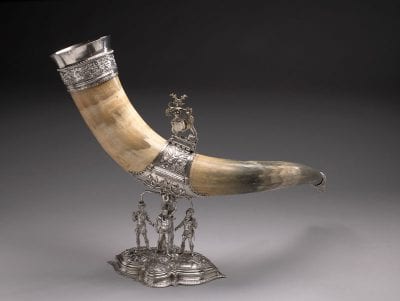
Furthermore there is nothing but joy and lust for life at the banquet:
The table is packed with generous, calm souls
Who, without fear or blame, celebrate peace
And attack their pastries and roast bravely,
Enjoying what brings joy and defeats thirst.26
The beautiful golden glass holder (bekerschroef, fig. 5) that is used by the sergeant in gray is one of four still present at city hall.27 It is curious that the main character in the Civic Guards Meal succeeded the main figure in the Nightwatch as colonel of the civic guards. Witsen replaced Cocq in that position in 1650.
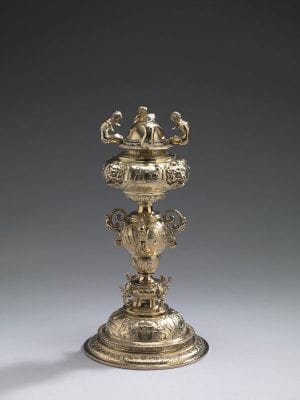
After the completion of the Civic Guards Meal, not many more civic guard pieces were painted. Was it felt that nothing more could be delivered that would not be overshadowed by what already existed? Were the rooms already full? Did the fancy for this subject peter out? One of the most prominent reasons was fostered by the reorganization of the civic guards, which, after the attack by Prince William II, were increased from twenty to fifty-four squads, with a completely new distribution of districts. Also the change in customs challenged the camaraderie and coziness of the old organization of the civic guards. In the second half of the seventeenth century, the dignity of the patricians who led the squads of burghers apparently did not allow their depiction with common civic guards in one painting, certainly not in a common drinking bout!

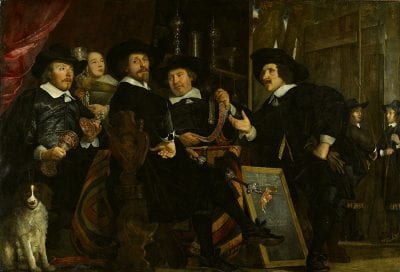
Nevertheless now and then this type of art was still called on to decorate civic guard halls. But now it was used to depict “governors” [overseers]28 in regent portraits above the fireplace. That of the Harquebusier Civic Guard had already served as forerunner (the painting by Flinck, no. 31 of the city, now in the [Rijks]museum) (fig. 6).29 And the governors of the Longbow Civic Guard Hall had, at the time when Schaep made his repeatedly mentioned “Record and list of the public paintings kept at the 3 civic guard halls” (Ao 1653),30 already transferred a painting that had hung until then as a chimneypiece in the large hall to the “small room above the gate,” in order to make room for the portrait that would show their likenesses. This commission was given to Van der Helst. One can now see in the museum how he carried out that task — in one of the compartments on the right hand side of the Hall of Honor (the city’s no. 41) (fig. 7)31 — because luckily it is still intact, for the most part. It is one of the most beautiful portraits of the Dutch School because of its carefully worked composition and color harmony. In the Trippenhuis, it served as proof of Van der Helst’s merits in composition for a long time. The four governors sit around a table that is covered with a Turkish carpet and are occupied with viewing the art treasures (nowadays still partly present, see fig. 4, fig. 8, fig. 9) of the civic guard hall. To the left, one of the governors lifts the lid of a golden chalice. According to his portrait by [Jan] de Bray that adorned the Historische Tentoonstelling in Amsterdam, this is Vondel’s friend Dr. Joan Blaeu, who had been an alderman since 1651 and was a famous printer whose beautiful and precise atlases have secured his fame until this day.32 Behind the table, Albert Dirksz, the brewer’s son from De Zwaan who became burgomaster in 1654, shows the chain that used to adorn the shooting kings in earlier times. Meanwhile we see their ebony wood staff, which had not yet lost its gilded parrot, in the hand of the governor, whose seat on the back shows an image of Sebastian, pierced with arrows. Based on its similarity to his portrait in the civic guard piece by Johannes Spilberg (no. 104 of the city, now in the hall of non-Dutch art in the Rijksmuseum) (fig. 10),33 we see in this figure the alderman and civic guard captain Jan van de Poll. The fourth of the gentlemen is therefore Frans Banning Cocq, with his gloves and the same hand gesture that Rembrandt immortalized. However, the color of his hair suggests that he liked to have himself painted in more than one way and with multiple meanings.

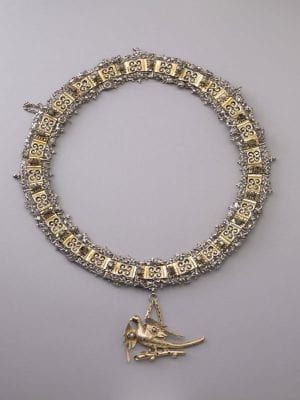
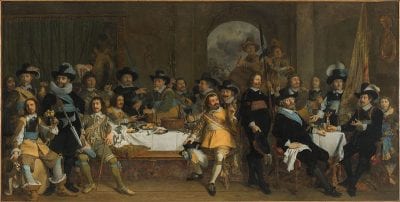
In the background, we see a rack on which cups, mugs, and bowls are displayed, with silver spoons hanging below. The large drinking horn of the civic guard guild is carried in by a woman.34 Had the portrait been painted twelve years later, we would have seen the widow of Jacob van der Helst35 in that woman, who, according to Bontemantel, had such a “great trade” as keeper in the civic guard hall that a room had to be added. After her, the civic guard hall was named the “Van der Helstdoelen,” which has occasioned the nonsense that our Bartholomeus had been keeper of the civic guard hall. Van Dyk already contradicted this delusion in his Beschrijving der Schilderijen (1758), but he did this on peculiar grounds. First he argued that Christoffel Pook was keeper [kastelein] from 1644 until 1658, which is true, but for the Crossbow Civic Guard Hall. Secondly, he argued that one of the four persons in the painting, sitting at the table with his head covered, is in fact the painter himself, to whom the three governors show the civic guards’ insignia. The proof, he says, is in the painting itself; on the large slate that leans again the table appear four names: Pater, Blauw, Van de Pol, B. van der Helst.
This is still true today: we see only three names in the painting, apart from the painter’s name. That of Banning Cocq is not there. The assertion that this burgomaster [Banning Cocq] and not Van der Helst was the fourth of the depicted gentlemen appears in Commelin’s Beschrijving van Amsterdam (p. 664)36 and in the list by Schaep. Why then is his name not on the slate? One could answer that the slate, as is clearly visible, has been overpainted and sloppily so. One can make out the following names: D. Pater, H. van Poll, and P. Blauw. Under the latter name, A. D. De Vries believed he could distinguish the faint letters d. Iohan.
It seems clear as well that the signature of Van der Helst has been reapplied on the painting. This also deprives all value from the year 1657 that presently appears on the painting. When Schaep wrote his description in 1653, room had already been made for this portrait, as I mentioned above, and there is no probability that they would have waited four years to have it painted. Furthermore Banning Cocq passed away on January 1, 1655. This painting was therefore painted in 1653, the date that is also mentioned by Van Dyk on p. 39 (on p. 40 he notes 1658, but this is surely a typographical error).37
This year, 1653, also appears in a small copy (0.50 x 0.67) by our painter, a repetition that is owned by the Louvre, Paris.38 Its provenance is the family De Graef van Polsbroek, and because they were heirs of Banning Cocq, this little painting was probably commissioned from Van der Helst by the latter for his private collection.39 It later became part of the cabinet of Gerrit Braamcamp and, with the sale of this collection in 1771, it came into the hands of P. Locquet for f730. From his collection it was later sold for f1800. Later, it was worth 10,000 livres. That this work is a faithful copy of the large one is proven by the drawing in the aforementioned album of Banning Cocq in which this civic guard portrait is also copied.40 From the latter, it appears that more alterations have occurred. The young men with bows in the right corner of the painting and behind whom the shooting range is visible (indicated by bullet traps and trees) number only three in the Louvre piece. But, it is also remarkable that in the Parisian painting, except for the painter’s signature, there are only three names on the slate and the first names differ from those of the governors. In Amsterdam, one reads D. Pater, H. van Poll, P. Blau, while in Paris, P. Blau, B. van Pol, D. Pater. This inspired A. D. de Vries to suggest that perhaps the names on the slate are not those of the depicted governors, but those of the three (in Amsterdam only two remain) young men carrying bows and arrows; these could have been sons of the governors. They are presented here as having held a contest, which is also suggested by the points that are noted on the slate. There is much to recommend in this idea.41 One of the sons of Blaeu was called Pieter and Van de Poll had a son who was called Herman. If Albert Dircksz Pater had a son, it is not improbable that he carried the name of his grandfather and Banning Cocq had no children.
If this assumption is correct and the first letters in Amsterdam are therefore right, it is still no less true that a part of the painting, including that in which the slate is depicted, has been overpainted and that the small figures on the background were originally three in number.
This portrait (fig. 7) has had a somewhat different life cycle than the other civic guard pieces. In Van Dyk’s time it was not yet at the city hall, but still served as a chimneypiece in the Longbow Civic Guard Hall, or as they called it then the “Garnalendoelen.” However in 1775, it had been transferred to the art room in the city hall, according to a note by Ploos van Amstel on a drawing after the painting that he bought in 1754 from the cabinet of Burgomaster Ter Smitten.42 Later it enjoyed the honor of being deemed worthy to move to the Rijksmuseum of the Trippenhuis with the Nightwatch and the Civic Guards Meal.
![Bartholomeus van der Helst, The Governors of the Harquebusiers [Kloveniers] , 1655, Amsterdam Museum](https://jhna.org/wp-content/uploads/2017/03/Meijer6.1-3-11-400x239.jpg)
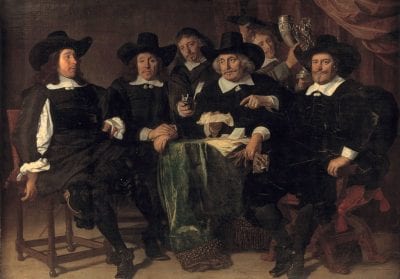
Two other governors portraits by Van der Helst moved to the Prinsenhof,43 however, and they still adorn the burgomaster’s room there as they used to do in the treasury on the Dam (fig. 11, fig. 12). These works deserve greater recognition and fame because they are some of the most beautiful works produced in an era already famous for beautiful art. The works have not been discussed a great deal in art history either. The only descriptions of them known to me are given by Dr. Scheltema in his Aemstel’s Oudheid I, 17044 and in his Historische Beschrijving der Schilderijen van het Raadhuis, nos. 38 and 39.45 And there, for the latter work (fig. 12), he gives some details that are not correct.46 It is here again that Van Dyk leads down the wrong track anyone who does not approach his work with the utmost caution. In his zeal to bring to the stage the keeper of the civic guard hall (the brother of Van der Helst), he represents him as the man who serves the gentlemen at their meal of oysters. Because of that, he places the work in the Longbow Civic Guard Hall, although he also mentions him as the successor of Pook, who is present in the other portrait. If true, this would point us towards the Crossbow Civic Guard Hall.
This notion was adopted by Scheltema, but incorrectly. The portrait comes from the Harquebusiers Civic Guard Hall. If we consult the old city descriptions we see that, out of the four governors pieces, there were two in the Harquebusiers Civic Guard Hall, one in the Crossbow Civic Guard Hall and also only one in the Longbow Civic Guard Hall. We have already discussed the work in the Longbow Civic Guard Hall (fig. 7). We will explore the work in the Crossbow Civic Guard Hall below (fig. 12).47 Both can be identified by the depictions of their respective drinking horns. Of the portraits in the Harquebusiers Civic Guard Hall, the earliest one, which used to be in the great hall, is by Flinck, now located in the new [Rijks]museum) (fig. 6, for the drinking horn in the painting, see fig. 13). The latest, commissioned by later governors, according to Domselaer (4th book p. 211),48 was above the chimney of the governors’ room below the hall (fig. 11). He mentions neither painter nor year. Van Dyk, however, offering no reasonable support, placed no. 39 (in the city’s current numbering scheme) in the Longbow Civic Guard Hall (while there is no evidence that a second governors group was present there).
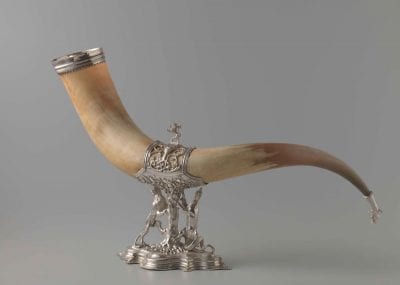
We then are left to question where the latest portrait of the Harquebusiers had gone. Luckily, Domselaer mentions the names of the gentlemen in the work. They are Cornelis Witsen, Roelof Bicker, Gerrit Reijnst, and Simon van Hoorn. The first mentioned, the main character in the Civic Guards Meal (fig. 1), we see in no. 3949 at the left hand side of the spectator. He speaks to a colleague with reddish hair, who is sitting opposite him on a chair with a red back. The supposition that he bears the name Reijnst is not refuted by the portrait by Karel Dujardin, formerly in the Trippenhuis, presently in the new museum (no. 171, portrait hall).50 At the front of the table, one of the gentlemen is seated on a stool with a red pillow with a glass of Rhine wine in his hand. Behind the table, another gentleman squeezes a lemon above his oyster. The friends seem to gather cozily together, though less homey than to our standards, because they are all wearing broad-brimmed hats and cloaks. Reijnst even wears his sword on his side. The clothing is all black. The painterly, brightly colored civic guard costumes are now a thing of the past. Behind the gentlemen one sees the keeper of the civic guard hall, who comes in to put a pewter wine tankard on the table, a woman with a new stock of oysters, and a young man. There is a dark background.51
The work is signed “Bartholomeus van der Helst 1655” on one of the legs of the chair on which Witsen is seated. [Because of this], Mr. Scheltema has changed his opinion (Aemstel’s Oudheid, I, 170) that it was painted ten years after the portrait of 1656, according to his Historische Beschrijving der schilderijen.
The other work in the burgomaster’s room (no. 38, new numbering) (fig. 12)52 is signed “B. van der. Helst. Fecit 1656.” The four gentlemen, introduced to us here, are the governors of the Crossbow Civic Guard Hall. In one of the folios that Schaep filled with all kinds of notes, and in which the repeatedly quoted list also appears, I found the names of the governors in his entries for 1653. They were Hendrik Dirksz Spiegel, Joris Backer, Jan Huydecoper, and Francois van der Meer. The latter died in 1653, but the others can still have occupied the function in 1656, although whoever replaced Van der Meer [in 1653] is unknown to me.53
Mr. C. Schöffer here, in Amsterdam, is in the possession of four small but delicately executed portraits [on one sheet, 1827]. They are pencil drawings of four heads from seventeenth-century civic guard or regent portraits. One of them is Banning Cocq, another Cornelis de Graeff, after the work by Backer in the council hall. A third carries the inscription Huydecoper.54 The latter is taken from the figure, who, holding gloves, sits on the right-hand side of our Crossbow Civic Guard Hall piece (fig. 12). He is the art-loving burgomaster whom we shall meet again later in a large piece by Flinck. Next to him we recognize, from the portrait engraved by [Pieter] Holsteyn, the lively head of the then fifty-eight-year-old Hendrik Dirksz Spieghel, who is reading a letter to the others. Behind him there is a servant with the famous silver drinking horn of the Crossbow Civic Guard, with St. George (fig. 14).55 All are dressed in black. Seated to the left, the governor, a person with an unpleasant appearance, has a sword on his side and wears sleeves split from the wrist to the shoulders that show the white undergarment. A person places a pewter ink bottle on the table, which is covered by a green carpet with gold fringe. On that ink bottle one reads the name “C. Pook.” Indeed the last keeper of the Crossbow Civic Guard Hall was called Stoffel (Christoffel) Pook according to Bontemantel’s papers.56 Thus Van Dyk (p. 96) was right this time when he found the name of the keeper here. But, he forgot that if Jacob van der Helst had been Pook’s successor, as he says later, the latter should also have been working in the Crossbow Civic Guard Hall. According to the nameplate, Pook also appears in the Civic Guards Meal — his name can be found on a pewter tankard.
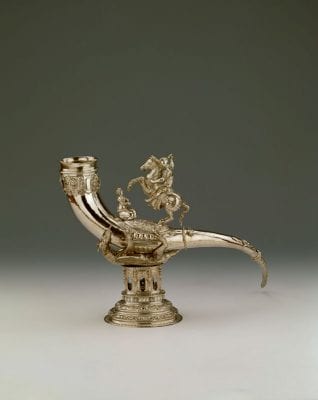
Of the life circumstances and family relations of Van der Helst, not much has been known until now. From fifty notes in baptismal books, marriage registers, and notary protocols, partly collected by De Vries, partly kindly put at my disposal by Mr. De Roever and Mr. Bredius, I have been able to reconstruct the genealogy of more than one family Van der Helst or Van der Elst (that spelling frequently occurs interchangeably). However, I have not been able to ascertain if these families had a family connection to the painter.
That Van der Helst was born in 1611 or 1612 in Haarlem is apparent from the entry in the marital register. But, since no note of his baptism in Haarlem has been found in the register few facts can be known with certainty about his parents.57 We can be sure, however, that he was not the son of the Dordrecht-born Severyn van der Helst, who settled in Haarlem and was mentioned as his father in Aemstel’s Oudheid (I, 164).58 According to his own testament, his father was called Lodewijk. I deem it probable that he descends from Carel Lodewijksz van der Helst,59 who appears as a merchant in Amsterdam in 1596 and who was a burgher there in 1605 and a wine buyer in the St. Jansstraat, where the gable stone of his house read Danswyck (the old Dutch name of the city Danzig [Gdansk]). He signed an act that year with a Haarlem notary in which a certain Gooswijn Bartelmeusz appears as an intermediary. He was an in-law of Jan de Haen, a merchant from Aachen, but living in Utrecht. We involuntarily think of the children of these brothers-in-law, when we find that Lodewijk van der Helst, who lived as a merchant in Haarlem in 1612, assisted in 1625 at the marriage of his cousin Jacob de Haen from Haarlem to Jannetje Bosijns, also from Haarlem, in the Wolvenstraat. We are all the more inclined to see in this Lodewijk a Carel Lodewijk van der Helst, the father and the grandfather of our painter, because we also find the name De Haen in the Du Pire family into which Bartholomeus married.
From 1613 to 1627 we find a Lodewijk van der Elst as an innkeeper in Amsterdam on the Heeremarkt (he had a rental debt there). If he was the father of the painter, then Bartholomeus would have gone to Amsterdam from Haarlem as a very young child. It is then very natural that Van der Helst was not influenced by Frans Hals, but was formed in the Amsterdam workshops.
We know with more certainty than the speculations concerning his father that his brother, also called Lodewijk, was a silk manufacturer by profession. He was born in Haarlem in 1610, but was living on the Lindengracht in Amsterdam when he married Catharina de la Quellerie from Wesel in 1632 (her mother was called Jannetje Brebie). In 1655, he married Neeltje Finsom, but he had children from his first marriage, one of whom was named Bartholomeus. When he was baptized on January 29, 1637, Bartholomeus van der Helst and Guillam de Quellerie were witnesses. Lodewijk and his wife Catharina were likewise witnesses when the painter had his son Bartholomeus baptized in the Nieuwe Kerk on April 3 of that year, the first offspring from his marriage to Anna du Pire.
There is something romantic about the marriage of the young painter and the eighteen-year-old orphan, who on April 16, 1636, signed her name “Anna du Pire” with a steady hand next to his in the Amsterdam marriage register. She brought him into a family of good standing. Surely thanks to this marriage, he joined the wedding party in 1650 at “huis te Manpad”60 of the Amsterdam rector Jacobus Heiblocq and Maria de Lange (the stepdaughter of Hendrik Segers van der Camp, who had [later] married Hester du Pire); his name appears in the “Hey-geschreeuw” that Job van Meekeren chanted at that wedding.61 Later the wife and daughter of Van der Helst received a small bequest from the sale of the Huis te Manpad that seems to have belonged to Hester du Pire. Among the other heirs, the name of Hogendorp occurs and that of Guilielmo or Willem Sweers, who, at the wedding of Van der Helst and Anna du Pire, was called her uncle and guardian. The name of Hans, or Jan, Sweers, who also belonged to the Du Pire family, and whose widow is on the list of regentesses of the Walloon orphanage likewise appears. This, together with the fact that Van der Helst was buried in the Walloon church, points towards relations with the French parish. This explains the commission of the first large piece by Van der Helst. I refer to the regents portrait of the Walloon orphanage of 1637 that (as is demonstrated by Dr. Jan Six esq. in the important monograph in which he gave Claes Elias his deserved place62) with high probability introduces him as the teacher of Van der Helst.
At least six children were born from Van der Helst’s marriage: the already mentioned Bartholomeus; Susanna, baptized December 21, 1638; Aaltje, baptized November 29, 1640; Lodewijk, baptized February 2, 1642, yet died young; a second Lodewijk, who was thirty-two years old in 1677, and finally Johannes, baptized August 1, 1647. In 1644 and in 1648 children were buried from Van der Helst’s house in the Zuiderkerk. But many more times the joys of parenthood must have been disturbed, because only two children reached adulthood, Susanna and Lodewijk. The former was betrothed on February 13, 1660, to Pieter de la Croix, a broker, son of Jacob de la Croix from the Bloemstraat. She died as a widow in 1703. At the time of her marriage her parents lived in the Doelenstraat. We already saw that they lived on the Nieuwmarkt before and after that time. After 1663 they again moved to the “Kleuveniers-doelenstraet” and, because Anna also lived there at the time of her marriage, I suspect that she owned a house there. However, she probably did not die there, because in 1676 and 1677 she lived on the then new Herengracht, between the Reguliersgracht and the Vijzelstraat. She lived with her son Lodewijk, who, on January 2 of the latter year, was betrothed to Geertruyd de Haes from Cologne, living in the Nes, who was eight years younger than he. It has not become clear to me if this marriage was blessed with children.63
From the testaments that the widow made in 1671 and 1676, it seems that her circumstances were less than ample. Their cause appears in the inventory of her estate made in 1680 and published by Mr. Bredius in the Catalogus van ‘t Museum Kunstliefde te Utrecht.64They resulted from the great [financial] support she gave Susanna and her husband.
Concerning Lodewijk, he chose the career of his father, and thus Van der Helst resembled Rembrandt, who also had a son who handled the brush. Neither son was able to match the fame of the father. Lodewijk van der Helst, however, was more successful than Titus van Rhijn. Not without merit, at least, is the portrait, nowadays in the office of the city’s tax collector, that Lodewijk painted in 1670 of Antonie Verbeeck,65 the carillonneur of the Oude Kerk, who
with foot and fingers
knows to interlace sounds(and) numbs with the sound of bells
The purest church chorals
Plays with bells as cymbals…66
I mention this portrait (fig. 15), although it is no civic guard piece, not because I want to conclude with a verse by Vondel, but because it is still attributed to Bartholomeus van der Helst in Scheltema’s Beschrijving der Schilderijen van de Stad (no. 42), although it is clearly signed “L. v.d. Helst” and was already attributed to Lodewijk in the catalogue of the Historische Tentoonstelling in Amsterdam (no. 3225).
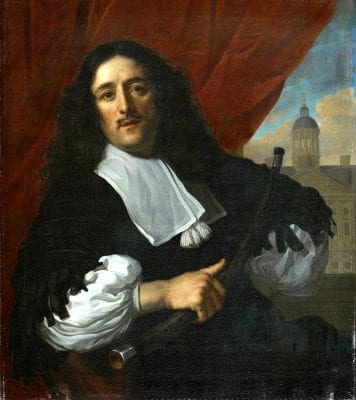
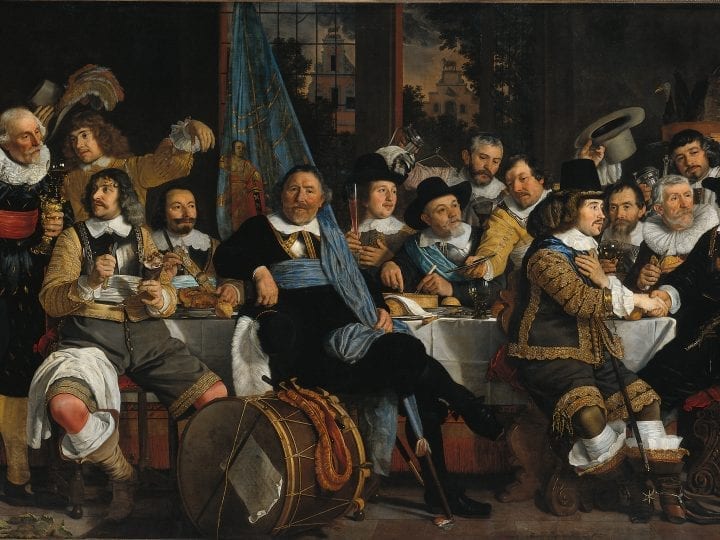










![Bartholomeus van der Helst, The Governors of the Harquebusiers [Kloveniers] , 1655, Amsterdam Museum](https://jhna.org/wp-content/uploads/2017/03/Meijer6.1-3-11-112x84.jpg)




